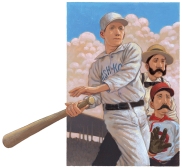 This week, I was lucky enough to have a thirty-minute window when I could pop into my favorite independent bookstore in Los Angeles. They have a large children’s section on the second floor that I love perusing because they do an excellent job at getting new books.
This week, I was lucky enough to have a thirty-minute window when I could pop into my favorite independent bookstore in Los Angeles. They have a large children’s section on the second floor that I love perusing because they do an excellent job at getting new books.
On one of their displays sat El Deafo by Cece Bell. Intrigued first by the illustration of a superhero bunny and second by the title, my immediate thought was “What is this book about and who is this written for?” As if by fate, a children’s book worker looked up from her task of stocking new books and said “Oh that’s a really cute story. I highly recommend it.” I inquired about the reading level and she said it could be from fourth grade to middle school. Opening it, I was stoked to find out it was a graphic novel. Sold. It may be one of the best impulsive $20 I’ve spent of late.
I read this book in two days. It follows the author’s childhood experiences of being deaf, and specifically highlights her experiences in school. What captured me was the depiction of how people treated her and, since it’s from Cece’s point of view, how she felt. Her emotions come through strongly in the text and illustrations, and made me stop and think about how I treat people even if my intention is good. I connected with Cece’s superhero persona, “El Deafo.” Cece uses El Deafo to imagine the ideal way to handle tough situations, even if that doesn’t play out in real life (something I did as a kid too). What I really loved about this book was how the author depicted her friendships with the other kids (the good and the bad). It reminded me that children can sometimes do really mean things but that most of the time they mean well and can be really amazing friends to each other. It’s a lesson I need to carry for the school year.
Cece’s journey starts at the age of four and ends in fifth grade, so as a fifth grade teacher, I’m very excited to bring this graphic novel to my classroom. I think the students will enjoy this book and learn a lot from it. I believe that it will carry lessons of tolerance and respect for those who are hearing impaired, and prepare my students with tools (Don’t cover your mouth while someone is lip reading! Don’t assume all deaf people can sign!) to create meaningful and comfortable experiences with someone who can’t hear well.
The post El Deafo appeared first on The Horn Book.



